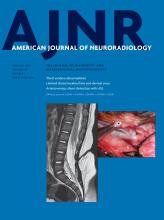Index by author
Baek, J.H.
- Head and Neck ImagingYou have accessPerformance of CT in the Preoperative Diagnosis of Cervical Lymph Node Metastasis in Patients with Papillary Thyroid Cancer: A Systematic Review and Meta-AnalysisC.H. Suh, J.H. Baek, Y.J. Choi and J.H. LeeAmerican Journal of Neuroradiology January 2017, 38 (1) 154-161; DOI: https://doi.org/10.3174/ajnr.A4967
Baharvahdat, H.
- FELLOWS' JOURNAL CLUBAdult BrainYou have accessIntracranial Arteriovenous Shunting: Detection with Arterial Spin-Labeling and Susceptibility-Weighted Imaging CombinedJ. Hodel, X. Leclerc, E. Kalsoum, M. Zuber, R. Tamazyan, M.A. Benadjaoud, J.-P. Pruvo, M. Piotin, H. Baharvahdat, M. Zins and R. BlancAmerican Journal of Neuroradiology January 2017, 38 (1) 71-76; DOI: https://doi.org/10.3174/ajnr.A4961
Ninety-two consecutive patients with a known (n = 24) or suspected arteriovenous shunting (n = 68) underwent DSA and brain MR imaging, including arterial spin-labeling/SWI and conventional angiographic MR imaging. DSA showed arteriovenous shunting in 63 of the 92 patients. Interobserver agreement was excellent. In 5 patients, arterial spin-labeling/SWI correctly detected arteriovenous shunting, while the conventional angiographic MR imaging did not. The authors conclude that the combined use of arterial spin-labeling and SWI may be an alternative to contrast-enhanced MRA for the detection of intracranial arteriovenous shunting.
Barburoglu, M.
- NeurointerventionOpen AccessFlow Diverters in the Treatment of Pediatric Cerebrovascular DiseasesM. Barburoglu and A. AratAmerican Journal of Neuroradiology January 2017, 38 (1) 113-118; DOI: https://doi.org/10.3174/ajnr.A4959
Barnaure, I.
- Spine Imaging and Spine Image-Guided InterventionsYou have accessDynamic Contrast-Enhanced MR Perfusion of Intradural Spinal LesionsV. Cuvinciuc, M. Viallon, I. Barnaure, M.I. Vargas, K.-O. Lovblad and S. HallerAmerican Journal of Neuroradiology January 2017, 38 (1) 192-194; DOI: https://doi.org/10.3174/ajnr.A4995
- Adult BrainOpen AccessClinicoradiologic Correlations of Cerebral Microbleeds in Advanced AgeI. Barnaure, M.-L. Montandon, C. Rodriguez, F. Herrmann, K.O. Lövblad, P. Giannakopoulos and S. HallerAmerican Journal of Neuroradiology January 2017, 38 (1) 39-45; DOI: https://doi.org/10.3174/ajnr.A4956
Barral, M.
- NeurointerventionYou have accessImpact of Modified TICI 3 versus Modified TICI 2b Reperfusion Score to Predict Good Outcome following Endovascular TherapyC. Dargazanli, A. Consoli, M. Barral, J. Labreuche, H. Redjem, G. Ciccio, S. Smajda, J.P. Desilles, G. Taylor, C. Preda, O. Coskun, G. Rodesch, M. Piotin, R. Blanc and B. LapergueAmerican Journal of Neuroradiology January 2017, 38 (1) 90-96; DOI: https://doi.org/10.3174/ajnr.A4968
Benadjaoud, M.A.
- FELLOWS' JOURNAL CLUBAdult BrainYou have accessIntracranial Arteriovenous Shunting: Detection with Arterial Spin-Labeling and Susceptibility-Weighted Imaging CombinedJ. Hodel, X. Leclerc, E. Kalsoum, M. Zuber, R. Tamazyan, M.A. Benadjaoud, J.-P. Pruvo, M. Piotin, H. Baharvahdat, M. Zins and R. BlancAmerican Journal of Neuroradiology January 2017, 38 (1) 71-76; DOI: https://doi.org/10.3174/ajnr.A4961
Ninety-two consecutive patients with a known (n = 24) or suspected arteriovenous shunting (n = 68) underwent DSA and brain MR imaging, including arterial spin-labeling/SWI and conventional angiographic MR imaging. DSA showed arteriovenous shunting in 63 of the 92 patients. Interobserver agreement was excellent. In 5 patients, arterial spin-labeling/SWI correctly detected arteriovenous shunting, while the conventional angiographic MR imaging did not. The authors conclude that the combined use of arterial spin-labeling and SWI may be an alternative to contrast-enhanced MRA for the detection of intracranial arteriovenous shunting.
Benson, J.C.
- Adult BrainYou have accessAcute Ischemic Stroke Infarct Topology: Association with Lesion Volume and Severity of Symptoms at Admission and DischargeS. Payabvash, S. Taleb, J.C. Benson and A.M. McKinneyAmerican Journal of Neuroradiology January 2017, 38 (1) 58-63; DOI: https://doi.org/10.3174/ajnr.A4970
Berlis, A.
- NeurointerventionYou have accessTreatment of Intra- and Extracranial Aneurysms Using the Flow-Redirection Endoluminal Device: Multicenter Experience and Follow-Up ResultsF. Drescher, W. Weber, A. Berlis, S. Rohde, A. Carolus and S. FischerAmerican Journal of Neuroradiology January 2017, 38 (1) 105-112; DOI: https://doi.org/10.3174/ajnr.A4964
Bharatha, A.
- Spine Imaging and Spine Image-Guided InterventionsYou have accessFirst-Pass Contrast-Enhanced MRA for Pretherapeutic Diagnosis of Spinal Epidural Arteriovenous Fistulas with Intradural Venous RefluxS. Mathur, S.P. Symons, T.J. Huynh, P. Muthusami, W. Montanera and A. BharathaAmerican Journal of Neuroradiology January 2017, 38 (1) 195-199; DOI: https://doi.org/10.3174/ajnr.A5008
- Spine Imaging and Spine Image-Guided InterventionsYou have accessFirst-Pass Contrast-Enhanced MR Angiography in Evaluation of Treated Spinal Arteriovenous Fistulas: Is Catheter Angiography Necessary?S. Mathur, S.P. Symons, T.J. Huynh, T.R. Marotta, R.I. Aviv and A. BharathaAmerican Journal of Neuroradiology January 2017, 38 (1) 200-205; DOI: https://doi.org/10.3174/ajnr.A4971
- Spine Imaging and Spine Image-Guided InterventionsYou have accessComparison of Time-Resolved and First-Pass Contrast-Enhanced MR Angiography in Pretherapeutic Evaluation of Spinal Dural Arteriovenous FistulasS. Mathur, A. Bharatha, T.J. Huynh, R.I. Aviv and S.P. SymonsAmerican Journal of Neuroradiology January 2017, 38 (1) 206-212; DOI: https://doi.org/10.3174/ajnr.A4962
Bisecco, A.
- EDITOR'S CHOICEAdult BrainOpen AccessHippocampal and Deep Gray Matter Nuclei Atrophy Is Relevant for Explaining Cognitive Impairment in MS: A Multicenter StudyD. Damjanovic, P. Valsasina, M.A. Rocca, M.L. Stromillo, A. Gallo, C. Enzinger, H.E. Hulst, A. Rovira, N. Muhlert, N. De Stefano, A. Bisecco, F. Fazekas, M.J. Arévalo, T.A. Yousry and M. FilippiAmerican Journal of Neuroradiology January 2017, 38 (1) 18-24; DOI: https://doi.org/10.3174/ajnr.A4952
Brain dual-echo, 3D T1-weighted, and double inversion recovery scans were acquired at 3T from 62 patients with relapsing-remitting MS and 65 controls. Focal WM and cortical lesions were identified, and volumetric measures from WM, cortical GM, the hippocampus, and deep GM nuclei were obtained. Compared with those with who were cognitively preserved, patients with MS with cognitive impairment had higher T2 and T1 lesion volumes and a trend toward a higher number of cortical lesions. Significant brain, cortical GM, hippocampal, deep GM nuclei, and WM atrophy was found in patients with MS with cognitive impairment versus those who were cognitively preserved. The authors conclude that hippocampal and deep GM nuclei atrophy are key factors associated with cognitive impairment in MS.








